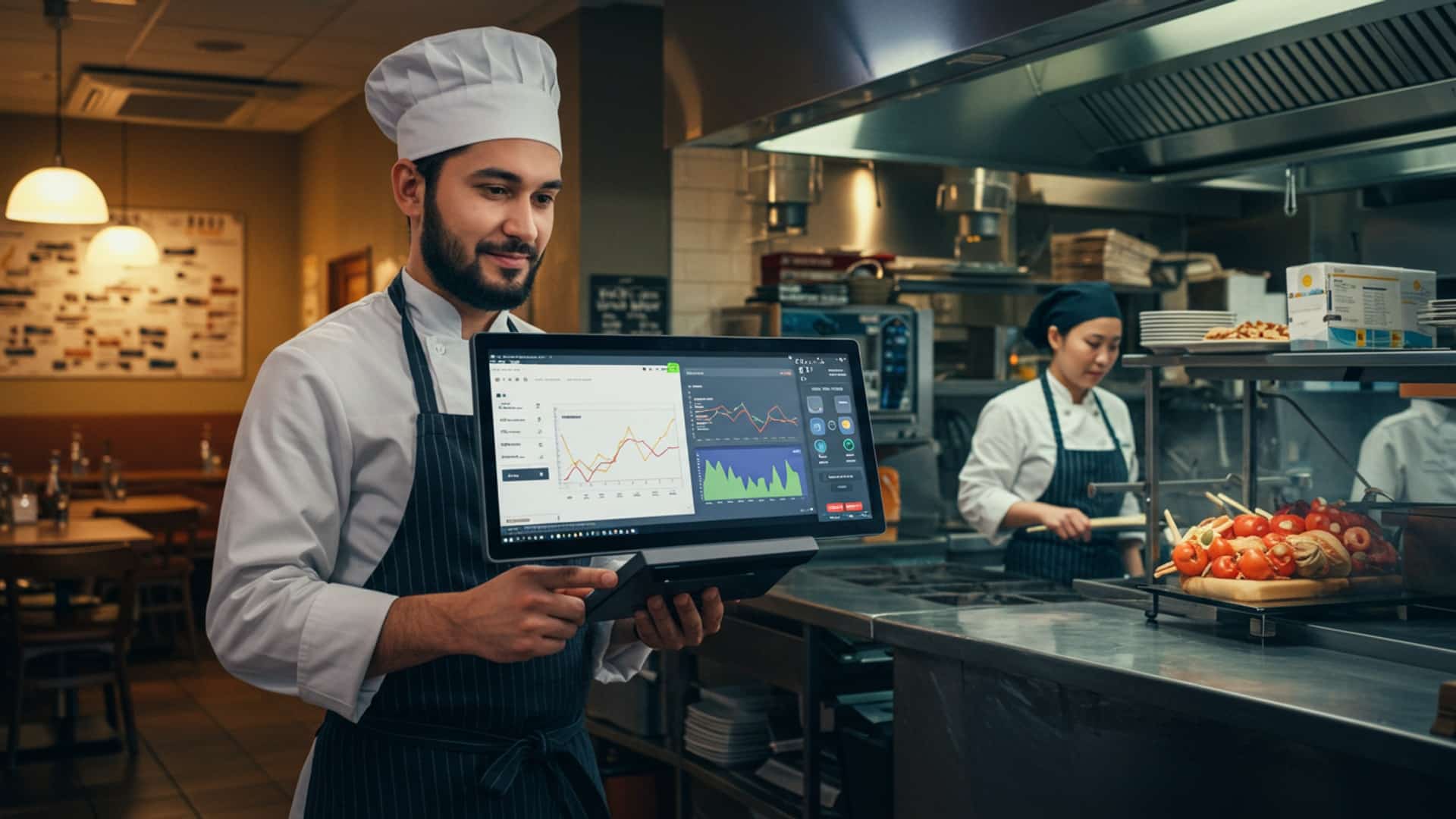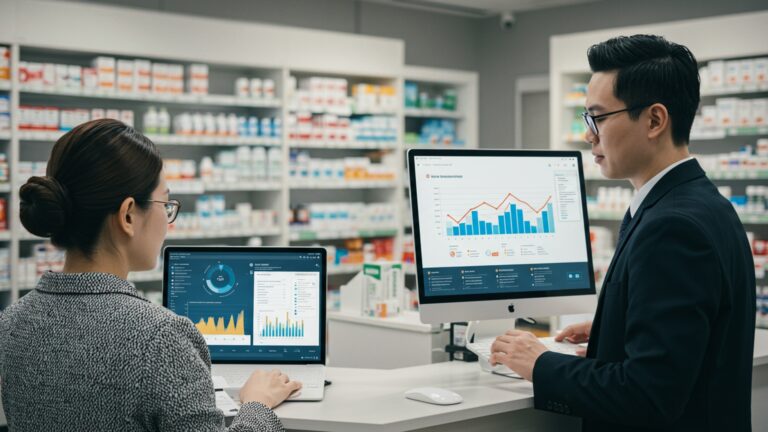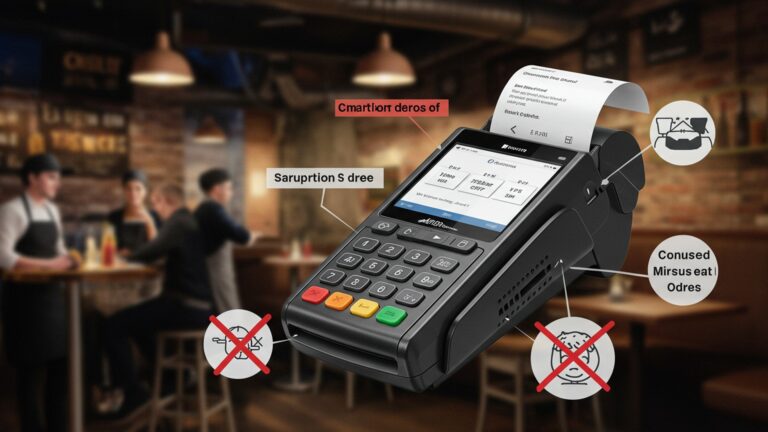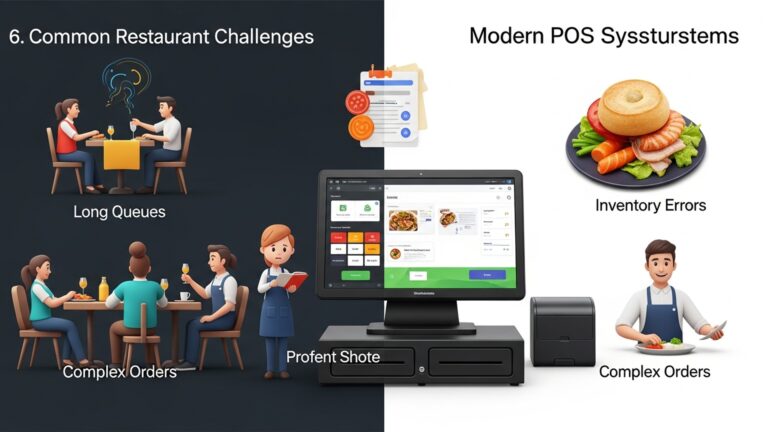A Guide to Mastering Restaurant POS for Seamless Operations
The modern restaurant ecosystem demands more than just efficient order taking; it requires a strategic operational core that drives profitability and guest satisfaction. Today’s advanced restaurant POS software transcends simple transaction processing, evolving into a dynamic hub for seamless operations. It integrates sophisticated features like AI-powered inventory management to minimize waste, enables dynamic menu pricing based on real-time demand. facilitates frictionless online ordering and delivery platform synchronization. From empowering staff with intuitive tableside ordering on handheld devices to leveraging predictive analytics for optimized labor scheduling and robust customer relationship management, mastering this pivotal technology transforms challenges into competitive advantages, ensuring peak performance in a rapidly evolving culinary landscape.

Understanding Restaurant POS Software: The Backbone of Modern Operations
In the fast-paced world of dining, efficiency is paramount. Gone are the days when a simple cash register and handwritten tickets sufficed. Today, the operational core of any successful restaurant, from a bustling cafe to a fine-dining establishment, is robust Restaurant POS software. But what exactly is it. why has it become so indispensable?
POS, which stands for Point of Sale, broadly refers to the place where a customer makes a payment for goods or services. In the context of a restaurant, it’s far more than just a cash register. Modern Restaurant POS software is an integrated system designed to manage every aspect of a food service business, streamlining operations from the moment an order is placed to when the customer pays and leaves.
Historically, restaurants relied on manual systems: order pads, physical cash drawers. separate systems for inventory and payroll. This led to inefficiencies, errors. a lack of real-time data. The evolution of POS technology transformed this, introducing computerized systems that could process transactions, track sales. even manage inventory. Today’s cloud-based Restaurant POS software takes this a step further, offering unparalleled accessibility, integration. data analytics capabilities.
Why is it crucial for modern restaurants? A well-implemented POS system acts as the central nervous system of your business. It reduces human error, speeds up service, enhances customer experience. provides invaluable insights into your operations. Without it, keeping pace with customer demands, managing complex menus. making data-driven decisions becomes incredibly challenging, if not impossible.
Key components of a typical Restaurant POS setup include:
- Touchscreen Terminals
- Payment Processors
- Printers
- Cash Drawers
- Kitchen Display Systems (KDS)
- Handheld Devices
For order entry, payment processing. staff management.
Devices for credit/debit card transactions, including EMV chip readers and contactless payment options.
For kitchen tickets, bar orders. customer receipts.
Secure storage for cash transactions.
Digital screens in the kitchen that display orders, replacing paper tickets.
Tablets or smartphones for tableside ordering and payment.
Core Features and Functionalities of Advanced Restaurant POS Systems
The true power of modern Restaurant POS software lies in its comprehensive suite of features, designed to optimize every facet of restaurant management. Understanding these functionalities is key to leveraging your system to its fullest potential.
- Order Management
- Menu Management
- Payment Processing
- Inventory Management
- Employee Management
This is the heart of any POS. It allows staff to quickly and accurately take orders, customize items with modifiers (e. g. , “no onions,” “extra cheese”), split checks. manage table assignments. Advanced systems support various order types – dine-in, takeout, delivery. online orders – all channeled through a single interface.
Real-world application: A server can take an order on a handheld device, which is immediately sent to the kitchen KDS, reducing walking time and speeding up service during peak hours.
Easily create, update. organize your menu items, pricing, specials. modifiers. This feature allows for quick adjustments, seasonal menu changes. seamless integration with online menus.
Actionable Takeaway: Regularly review your menu through the POS to identify slow-moving items or popular combinations that could be promoted.
Integrated payment processing streamlines transactions, supporting various methods including credit/debit cards (EMV compliant), mobile payments (Apple Pay, Google Pay). gift cards. This ensures secure and efficient payment collection.
Expert insight: “Seamless payment integration isn’t just about speed; it significantly reduces reconciliation errors and improves end-of-day closing procedures,” notes industry consultant, Maria Rodriguez.
Track ingredients, monitor stock levels, manage recipes. receive alerts for low stock. Some systems can even integrate with suppliers for automated reordering. This minimizes waste and ensures you always have necessary ingredients.
Case Study: “Before our new Restaurant POS software, we’d frequently run out of popular craft beers,” shares John, owner of a gastropub. “Now, the system tracks every pour and alerts us when stock is low, allowing us to reorder proactively. Our waste is down 10%!”
Manage staff schedules, track hours worked (time clock functionality), assign roles. monitor performance. This helps with payroll accuracy and optimizes labor costs.
Example:
// Example of a simple time-clock entry in a POS system's backend { "employee_id": "EMP001", "name": "Jane Doe", "clock_in": "2023-10-27T09:00:00Z", "clock_out": "2023-10-27T17:30:00Z", "role": "Server", "shift_duration_hours": 8. 5 }
Generate detailed reports on sales, popular items, labor costs, peak hours. customer spending habits. These insights are invaluable for making informed business decisions, identifying trends. optimizing operations.
Build customer profiles, manage loyalty programs, track preferences. collect feedback. This helps in personalizing service and driving repeat business.
Orders placed at the POS instantly appear on digital screens in the kitchen, improving communication, reducing errors. speeding up food preparation.
Seamlessly integrate with your website, mobile app. third-party delivery platforms. Orders flow directly into your POS, simplifying management and fulfilling an essential modern customer expectation.
Choosing the Right Restaurant POS Software: A Comparative Approach
Selecting the ideal Restaurant POS software is a critical decision that can significantly impact your restaurant’s efficiency, profitability. customer satisfaction. The market offers a diverse range of systems, each with its own strengths. Primarily, systems are categorized into on-premise and cloud-based solutions.
- On-Premise POS
- Pros: Greater control over data, potentially lower long-term costs (after initial investment). internet outages don’t halt operations.
- Cons: High upfront cost, requires IT expertise for maintenance and updates, limited accessibility. data backups are your responsibility.
- Cloud-Based POS
- Pros: Lower upfront cost (subscription model), automatic updates, remote access to data, enhanced data security (managed by provider). scalability.
- Cons: Requires a stable internet connection, ongoing subscription fees. less direct control over data.
This traditional model involves installing the software directly on your restaurant’s hardware (servers, computers). Data is stored locally.
This modern solution hosts the software and data on remote servers, accessible via the internet from any device.
Most modern restaurants, especially those looking for flexibility and advanced integrations, are gravitating towards cloud-based Restaurant POS software.
When evaluating different systems, consider these crucial factors:
- Cost
- Scalability
- Integrations
- Ease of Use
- Customer Support
- Hardware Requirements
Look beyond the upfront price. Consider subscription fees, transaction processing rates, hardware costs, installation. ongoing support.
Can the system grow with your business? If you plan to expand, open new locations, or add services (like catering), ensure the POS can adapt.
Does it integrate with other essential tools you use or plan to use, such as accounting software, online ordering platforms, loyalty programs, or inventory management systems?
A user-friendly interface reduces training time and minimizes errors. Staff should be able to navigate it intuitively.
What kind of support does the provider offer (24/7, phone, email, chat)? Responsiveness is key, especially during peak hours.
Is the software compatible with your existing hardware, or will you need to invest in new equipment?
Here’s a simplified comparison of feature considerations for different restaurant types:
| Feature/Consideration | Quick Service Restaurant (QSR) | Full-Service Restaurant (FSR) | Cafe/Bakery |
|---|---|---|---|
| Order Entry Speed | Critical (touchscreen, pre-set combos) | crucial (table management, modifiers) | crucial (quick item selection, custom drinks) |
| Table Management | Low priority (takeout focus) | High priority (seating, reservations, transfers) | Medium priority (limited seating, quick turnover) |
| Inventory Tracking | Medium (ingredients, packaged items) | High (detailed recipes, waste management) | High (baked goods, coffee beans, perishables) |
| KDS Integration | High (efficiency for drive-thru/pickup) | High (streamlined kitchen workflow) | Medium (coffee orders, simple food prep) |
| Loyalty Programs | High (repeat business, quick rewards) | Medium (personalized offers) | High (frequent visitor rewards) |
| Handheld Devices | Optional (for line busting) | High (tableside ordering, payment) | Optional (for busy periods) |
Real-world example: A local pizzeria, “Slice & Dice,” initially used a generic retail POS. They struggled with order customization, delivery management. tracking ingredient usage for their complex menu. After switching to a specialized Restaurant POS software with robust menu modifiers, integrated delivery modules. recipe-level inventory, they saw a 20% reduction in order errors and a significant boost in delivery efficiency, leading to higher customer satisfaction.
Implementing and Optimizing Your Restaurant POS Software
Successfully integrating a new Restaurant POS software into your operations is more than just plugging in hardware; it requires careful planning, thorough training. continuous optimization. This stage is crucial for realizing the full benefits of your investment.
Pre-Implementation Planning: Laying the Foundation
- Menu Setup
- Hardware Configuration
- Staff Roles & Permissions
- Data Migration
Accurately input your entire menu, including categories, items, pricing, modifiers, special instructions. ingredient lists for inventory tracking. This is often the most time-consuming step but critical for accuracy.
Actionable Takeaway: Create a detailed menu matrix before data entry. This ensures consistency and catches errors early.
Ensure all hardware components (terminals, printers, KDS, payment devices) are properly installed, connected. configured to communicate with the software.
Define different access levels for staff (e. g. , server, bartender, manager, owner) to control what functions they can perform.
If transitioning from an older system, plan how to migrate existing customer data, loyalty points, or inventory counts.
Go-Live Strategies: Smooth Transition
- Phased Rollout
- Shadowing
- Backup Plan
For larger establishments, consider a phased rollout, perhaps starting with one station or department before expanding to the entire operation. This allows you to identify and fix issues without disrupting the entire service.
During the initial days, have experienced staff or trainers “shadow” employees using the new system, providing immediate assistance and feedback.
Always have a manual backup plan (e. g. , paper order pads, a basic calculator) for the first few days, just in case of unexpected technical glitches.
Staff Training Best Practices: Empowering Your Team
Training is arguably the most critical component of a successful POS implementation. A powerful system is only as good as the people using it.
- Role-Based Training
- Hands-on Practice
- Cheat Sheets & Resources
- Continuous Learning
Customize training modules for different roles (servers need to know order entry and payment, kitchen staff need KDS, managers need reporting and inventory).
Provide ample opportunities for staff to practice on the actual system in a non-stressful environment before live service. Set up a “training mode” if available.
Create quick-reference guides for common tasks, troubleshooting tips. FAQs.
Schedule refresher courses or advanced training sessions as new features are released or as staff identify areas for improvement.
Leveraging Analytics for Operational Improvements: The Data Advantage
The true power of modern Restaurant POS software lies in its ability to generate vast amounts of data. Don’t let this data go to waste!
- Sales Trends
- Menu Performance
- Labor Cost Optimization
- Inventory Control
review daily, weekly, or monthly sales reports to identify peak hours, popular dishes. slow periods. Use this to optimize staffing, promotions. inventory.
Pinpoint your most profitable items versus those that are simply taking up space. Consider removing underperforming items or adjusting pricing.
Compare sales data with labor hours to ensure you’re appropriately staffed. Identify times when you might be over- or under-staffed.
Use inventory reports to identify waste, track ingredient usage against sales. refine your ordering process to reduce spoilage and carrying costs.
Actionable Takeaway: Dedicate specific time each week to review key performance indicator (KPI) reports generated by your Restaurant POS software. Don’t just collect data; review and act on it!
Troubleshooting Common Issues and Maintenance
- Connectivity Issues
- Printer Malfunctions
- Payment Processing Errors
- Regular Updates
- Data Backups
Ensure stable Wi-Fi or wired internet connection for cloud-based systems.
Check paper, ink/toner. connectivity.
Verify card reader connection and internet.
Keep your software updated to benefit from new features, security patches. performance improvements.
For on-premise systems, ensure regular, secure data backups. Cloud systems typically handle this automatically.
Real-World Impact: Case Studies and Actionable Takeaways
The transformative power of effective Restaurant POS software is best illustrated through real-world applications and the tangible benefits experienced by restaurateurs. These examples highlight how strategic implementation can lead to significant operational improvements and increased profitability.
Case Study 1: The Speedy Cafe’s Efficiency Boost
A bustling downtown cafe, “The Daily Grind,” was struggling with long queues during peak morning hours. Their old cash register system was slow, leading to frequent order errors and frustrated customers. After implementing a new cloud-based Restaurant POS software with integrated KDS and handheld ordering devices, they saw dramatic improvements.
- Problem
- Solution
- Result
- Reduced order errors by 30% within the first month.
- Increased average transaction speed by 15 seconds per order, significantly cutting down queue times.
- Enabled staff to take orders tableside during less busy periods, improving customer experience.
Slow order entry, manual communication to baristas, frequent errors, long customer wait times.
Implemented a user-friendly POS with touch-screen terminals for quick order entry, a KDS for the barista station. a customer-facing display for order verification.
Actionable Takeaway: For high-volume businesses, speed and accuracy are paramount. Invest in a Restaurant POS software that streamlines the order-to-preparation flow and minimizes manual intervention.
Case Study 2: Fine Dining Restaurant’s Inventory Revolution
“The Gilded Fork,” an upscale fine-dining restaurant, faced challenges with food waste and inconsistent dish costs due to manual inventory tracking. It was difficult to pinpoint exact ingredient usage or identify potential theft.
- Problem
- Solution
- Result
- Reduced food waste by 18% in six months by identifying over-portioned dishes and optimizing ordering.
- Accurately costed every dish, allowing for strategic menu pricing adjustments that increased profit margins by 5%.
- Streamlined weekly inventory counts from a full day to just a few hours.
High food waste, inaccurate ingredient costs, difficulty tracking high-value items. lengthy manual inventory counts.
Adopted Restaurant POS software with robust, recipe-level inventory management. Every dish sold automatically deducted ingredients from stock. the system provided real-time usage reports.
Actionable Takeaway: Don’t underestimate the power of detailed inventory management within your Restaurant POS software. It directly impacts your bottom line by controlling costs and reducing waste.
Case Study 3: The Pub’s Customer Loyalty Boost
“The Corner Pint,” a local pub, wanted to foster a stronger community and encourage repeat business but lacked a systematic way to reward loyal customers.
- Problem
- Solution
- Result
- Enrolled over 500 loyal customers in the first three months.
- Implemented targeted promotions, such as “Your Favorite IPA is on Special!” based on purchase history, leading to a 10% increase in repeat customer visits.
- Collected valuable feedback through POS-integrated surveys, allowing them to improve service.
No formal loyalty program, difficulty tracking customer preferences, missed opportunities for targeted marketing.
Utilized the CRM and loyalty features of their Restaurant POS software. Customers could sign up quickly at the POS, earning points for every purchase. The system also tracked their favorite drinks and food items.
Actionable Takeaway: Leverage the CRM capabilities of your Restaurant POS software to build stronger customer relationships. Personalized offers and loyalty programs are powerful drivers of repeat business.
Actionable Tips for Maximizing ROI from Your Restaurant POS Software:
- Regularly Review Reports
- Ongoing Staff Training
- Integrate Wisely
- Gather Customer Feedback
- Stay Updated
Make it a weekly habit to dive into your sales, labor. inventory reports. These insights are gold for decision-making.
As your menu evolves or new features are rolled out, provide continuous training to ensure your team is always using the system optimally.
Connect your POS with other critical software (accounting, online ordering, payroll) to create a truly unified operational ecosystem.
Use your POS to facilitate customer feedback, whether through digital receipts or integrated survey options.
Keep your software updated to benefit from the latest features, security enhancements. performance improvements.
The future of Restaurant POS software is exciting, with trends pointing towards even greater integration with AI for predictive analytics, voice ordering capabilities, advanced personalization based on customer habits. enhanced mobile accessibility. Mastering your current system today positions you perfectly to embrace these innovations tomorrow, ensuring your restaurant remains competitive and profitable.
Conclusion
Having journeyed through the intricacies of restaurant POS, you now possess the knowledge to transform your operations from chaotic to seamless. Don’t merely install a system; truly master it. My personal tip is to view your POS not just as a transaction tool. as a dynamic data hub. Regularly train your team beyond basic order entry, perhaps focusing on how to leverage integrated inventory features to minimize food waste, a significant challenge I’ve often observed in the industry. Embrace current trends like QR code table ordering, a recent development that dramatically enhances customer experience and reduces server load, especially during peak hours. For example, using your POS to track peak times can inform staffing decisions and even dynamic menu adjustments. This strategic approach, as detailed in how your restaurant POS can boost sales and efficiency, turns technology into a competitive advantage. Your restaurant POS is the heartbeat of your business; empower your team to use its full potential. watch your operations flow effortlessly, delighting both staff and patrons alike.
More Articles
Learn 7 Essential Restaurant POS Features to Improve Your Operations
Learn 8 Common Restaurant POS Software Mistakes and How to Avoid Them
How to Solve 6 Common Restaurant Problems with Smart POS Technology
Master 8 Key Features Your Restaurant POS System Must Have
5 Essential Tips to Choose the Best Restaurant POS Software System
FAQs
What’s the big deal with restaurant POS systems anyway?
Think of a modern POS as the brain of your restaurant. It’s not just for ringing up orders anymore; it handles everything from inventory and staff management to customer data and sales reporting. A great POS streamlines operations, reduces errors. ultimately helps you make more money and keep customers happy.
How can a POS system actually make my restaurant run smoother day-to-day?
It does a lot! Orders go straight from the server’s handheld to the kitchen display, reducing mistakes and speeding up service. Payments are processed faster, table management is easier. staff can focus more on guests instead of juggling manual tasks. Plus, you get real-time insights into what’s selling and what’s not.
Are there specific features I should really look out for when choosing a new POS?
Absolutely! Key features include intuitive order management (with modifiers), integrated payment processing, robust inventory tracking, employee scheduling and time clock functions, detailed sales reporting. CRM capabilities. Cloud-based access is also a huge plus for flexibility and remote management.
What are some common mistakes restaurants make when implementing a new POS. how can I avoid them?
A big one is not involving staff early in the process – their buy-in is crucial! Also, rushing the setup, neglecting thorough training. not customizing the system to fit your unique menu and workflow can cause headaches. To avoid this, plan meticulously, train comprehensively. don’t be afraid to ask your vendor for support.
My staff isn’t super tech-savvy. How difficult is it to train them on a modern POS?
Most modern POS systems are designed with user-friendliness in mind, often resembling familiar tablet interfaces. With proper, hands-on training and a clear guide, even less tech-savvy staff can pick it up quickly. The key is clear instructions, practice. showing them how it makes their job easier, not harder.
Beyond just taking orders, what other cool things can a good POS do for my business?
So much more! It can help manage your loyalty programs, track customer preferences for personalized service, identify your most profitable menu items, optimize staff scheduling based on predicted demand. even help you track food costs to prevent waste. It’s a goldmine of data for smart business decisions.
Is it really worth the investment for a small cafe or food truck?
Definitely! While the upfront cost might seem like a lot, the long-term benefits far outweigh it. Even small operations benefit from faster service, fewer errors, better inventory control. insights into sales trends. It frees up your time from manual tasks so you can focus on making great food and serving your customers.





